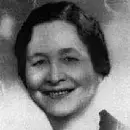
Ella Cara Deloria, Aŋpétu Wašté Wiŋ (Beautiful Day Woman)
Ella Cara Deloria, Aŋpétu Wašté Wiŋ (Beautiful Day Woman), was a Dakota Sioux scholar, ethnographer, writer, and translator, who recorded Sioux culture and languages at a time when the traditional culture was in danger of being lost.
Born on the Yankton Sioux Reservation and raised on the Pine Ridge Reservation in South Dakota, she was educated at Oberlin College (1910–1913) and Teachers College, Columbia University (B.S., 1915). While at Columbia, anthropologist Franz Boas hired her to work with his students in a course on linguistics because of her ability to speak Lakota. After college, Deloria taught from 1915–1919 at All Saints School in Sioux Falls, South Dakota; worked with the YMCA on a health education program for Indian schools; and went to Lawrence, Kansas, in 1923, where she taught dance and won renown for her physical education program. In 1927, she resumed her work with Boas (and later with Ruth Benedict and Margaret Mead). Her English translation of a Lakota text, “Sun Dance of the Oglala Sioux,” was published in the 1929 edition of the Journal of American Folklore. Other works followed, including Dakota Texts (1932), Dakota Grammar (1941), and Speaking of Indians (1944).
Deloria held positions at the Sioux Indian Museum in Rapid City, South Dakota, and was assistant director at the W.H. Over Museum at the University of South Dakota. She wrote the novel Waterlily (completed in 1948, published in 1988) about the daily life of a Teton Sioux woman. The book introduced Native American culture to non-scholars and non-Natives. Her nephew Philip J. Deloria (Harvard University) is a member of the Academy.
Image of Deloria from the Aktá Lakota Museum & Cultural Center.